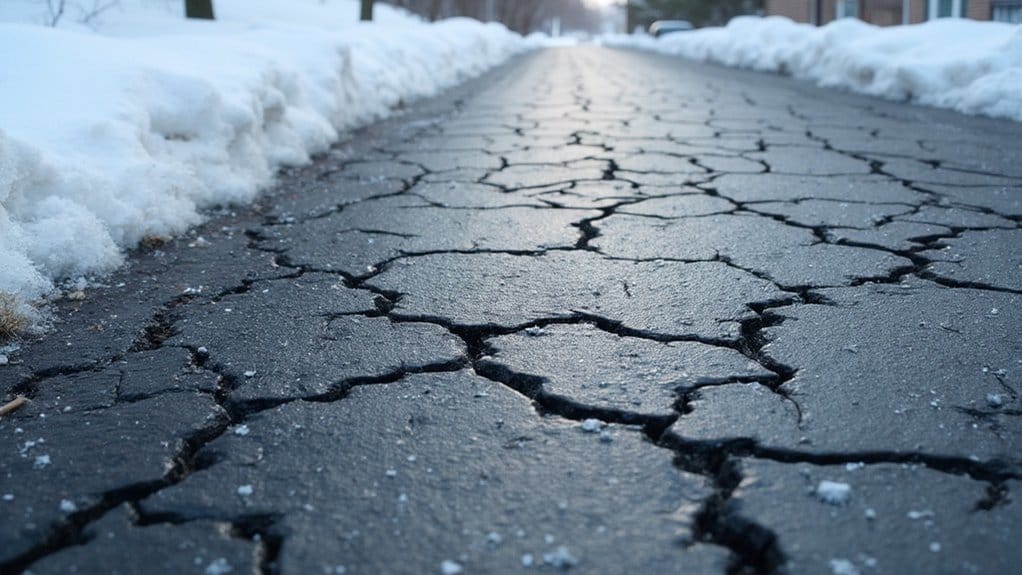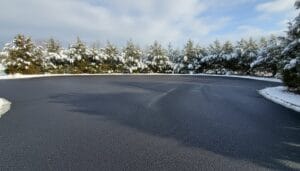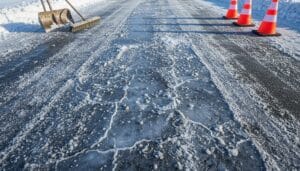Your snow removal methods can seriously damage your asphalt if you’re not careful! Improper plowing techniques and harsh de-icing chemicals create cracks that worsen through freeze-thaw cycles. To protect your pavement, keep plow blades ½ inch above the surface and use rubber-edged equipment.
Choose magnesium chloride over traditional salt for de-icing. Regular inspections and immediate crack repairs prevent small issues from becoming costly problems. Schedule professional sealcoating every 3.5 years for ideal protection.
Install markers along curbs to improve visibility during snow removal.
The more you know about proper winter maintenance, the longer your asphalt will last.
Key Takeaways
- Improper plow blade height and metal edges can scrape and gouge asphalt surfaces, requiring rubber-edged plows for safe snow removal.
- Excessive use of harsh de-icing chemicals weakens asphalt structure; opt for magnesium chloride or sand as safer alternatives.
- Water from melting snow seeps into existing cracks, freezes, expands, and worsens damage through continuous freeze-thaw cycles.
- Regular sealcoating every 3.5 years and prompt crack repairs prevent water infiltration and protect asphalt from winter damage.
- Maintaining plow blades half an inch above asphalt surface and installing markers along paths ensures effective snow removal without damage.
Common Types of Snow Damage
Several types of snow-related damage can wreak havoc on your asphalt surfaces during winter months.
Let’s investigate the most concerning snow accumulation effects and what you can do about them!
Freeze-Thaw Cycles
Your biggest enemy is the constant freezing and thawing of water in your asphalt.
Here’s what happens:
- Water seeps into tiny cracks
- It freezes and expands
- The expansion creates bigger cracks
- The cycle repeats – making damage worse!
Don’t ignore those small cracks! Proper asphalt repair techniques can save you thousands in the long run. The continuous cycle of freezing and thawing often leads to dangerous frost heaves and bulges. Regular maintenance, such as filling cracks with sealant, can significantly reduce the impact of these cycles.
Hidden Dangers
Snow and ice can mask developing problems:
- Cracks fill with frozen precipitation
- Damage continues underneath
- You won’t spot issues until spring
- Problems multiply while hidden
Take Action!
Your best defense is regular maintenance:
- Seal cracks before winter hits
- Schedule professional inspections
- Address repairs immediately
- Keep surfaces properly drained
Remember: Small investments in prevention now will protect your asphalt from devastating winter damage later. Your wallet will thank you!
Snow Plow Impact Zones
While regular maintenance helps prevent winter damage, snow plows can pose unique threats to your asphalt surfaces. Your pavement is especially vulnerable in certain key areas where plow blade materials meet uneven surface challenges. Professional snow removal services with proper equipment training significantly reduce the risk of surface damage and ensure high-quality repairs to any existing issues.
High-Risk Impact Zones
- Curbs and speed bumps face the greatest risk due to poor visibility.
- Areas with existing cracks become worse under plow pressure.
- Edges of parking lots take repeated hits from snow plow blades.
- Spots with uneven grading get scraped and damaged.
You’ll notice more problems in areas with drainage issues. These spots experience frost heave damage when water freezes and thaws repeatedly. The force of heavy plows only makes it worse!
Protection Strategies
- Mark your curbs and obstacles with visible stakes.
- Request rubber or polyurethane plow blades from your contractor.
- Keep the plow blade slightly raised (½ inch is ideal).
- Address drainage problems before winter hits.
Remember – areas with sudden grade changes need extra attention. Your snow removal contractor should adjust their technique in these sensitive zones.
Don’t wait until spring to find damage. Monitor these impact zones throughout the winter season!
Preventing Chemical Damage
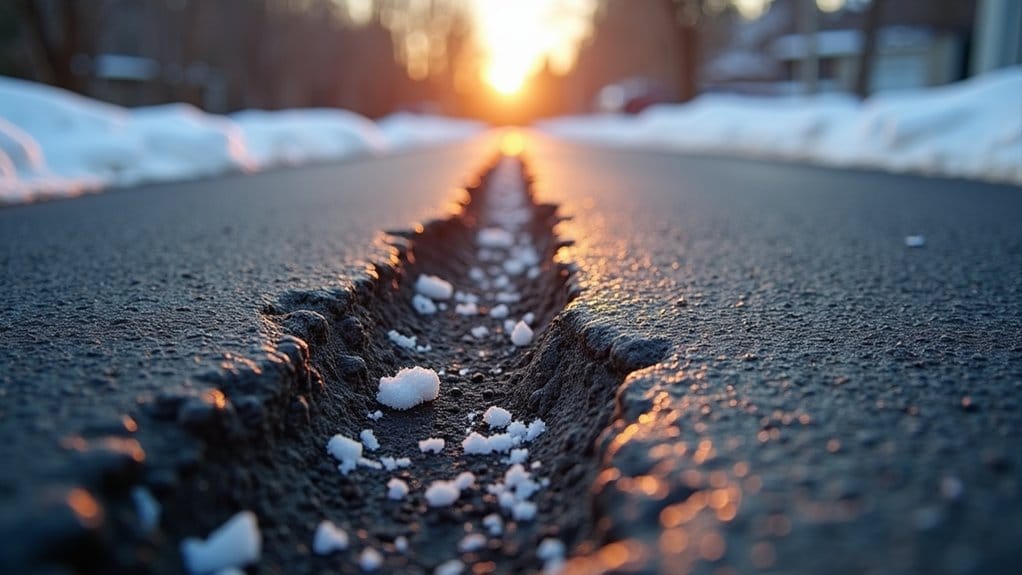
The effective prevention of chemical damage to asphalt requires careful consideration of your de-icing strategy.
You’ll need to balance safety with surface protection while considering environmental impact. Repeated salt applications can weaken pavement structure over time. Implementing a thoughtful approach to de-icing can significantly extend asphalt life by maintaining its integrity.
Choose Your Chemicals Wisely
Start by exploring chemical alternatives to traditional rock salt! Magnesium chloride offers excellent performance with less damage to your asphalt.
It’s a transformative solution for protecting your investment. Consider using a blend of de-icing materials to maximize effectiveness while minimizing surface wear.
Smart Application Techniques
- Apply chemicals evenly across your surface
- Use only what you truly need – less is more!
- Keep chemicals away from vegetation zones
- Consider sand for traction in less critical areas
Prep Work Matters
Don’t wait until winter hits! Take these protective steps now:
- Apply a quality sealcoat to shield your asphalt
- Fix drainage issues before freezing temperatures arrive
- Fill existing cracks to prevent water penetration
- Install proper drainage systems to prevent ice formation
Remember: Regular snow removal reduces your need for chemicals.
When you do need de-icers, choose products that balance effectiveness with surface protection.
Your asphalt will thank you with longer-lasting performance!
Protecting Against Freeze-Thaw Cycles
Repeatedly exposing your asphalt to freeze-thaw cycles can devastate its structural integrity. These cycles create a destructive pattern that weakens your pavement’s resilience over time. You’ll notice the damage starts small but quickly becomes severe!
Here’s what happens during freeze-thaw effects and how you can safeguard your investment:
| Stage | What Happens | What You Should Do |
|---|---|---|
| Initial | Water seeps into tiny cracks | Apply sealcoat immediately |
| Freezing | Water expands and widens cracks | Fill visible cracks promptly |
| Thawing | Ice melts, leaving larger gaps | Guarantee proper drainage |
| Repeat | Damage multiplies rapidly | Schedule regular inspections |
| Final | Potholes and structural failure | Consider professional repairs |
Don’t let freeze-thaw cycles destroy your asphalt! Take these protective steps:
- Install proper drainage systems
- Apply high-quality sealcoating annually
- Repair cracks as soon as you spot them
- Maintain a strong, well-compacted subbase
- Keep the surface clean and debris-free
Additionally, investing in high-quality sealcoating can significantly extend the lifespan of your asphalt surfaces, providing long-term savings.
Remember: Prevention costs much less than repair! By protecting your asphalt against freeze-thaw cycles now, you’ll save thousands in potential repairs later. Your pavement’s longevity depends on your proactive approach!
Professional Snow Removal Benefits
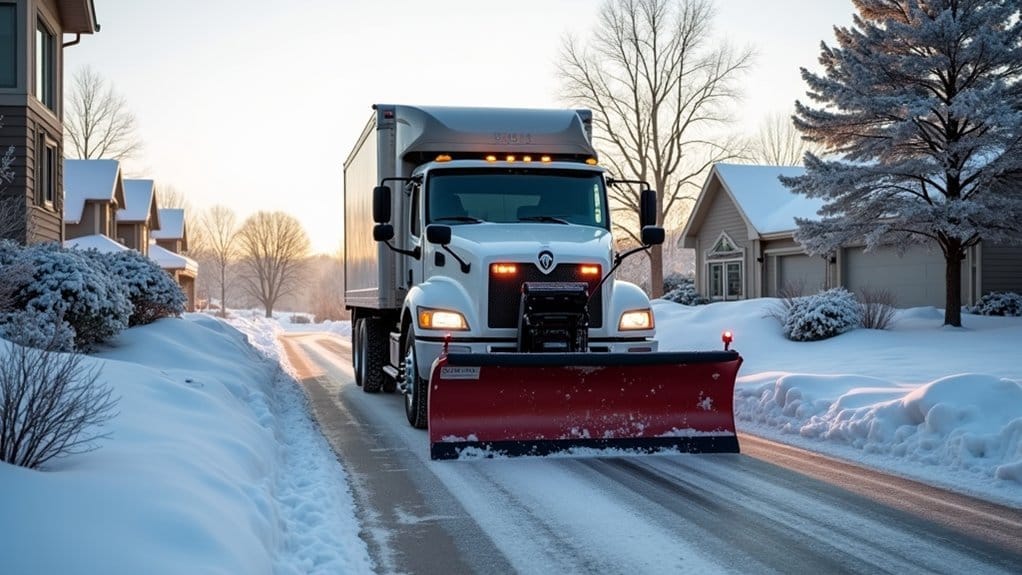
Protecting your asphalt against freeze-thaw cycles is just one part of winter maintenance – professional snow removal services offer another layer of defense for your pavement investment. Skilled contractors bring specialized equipment and proven snow removal techniques that safeguard your asphalt surface from damage.
Professional services deliver impressive advantages that make them worth every penny:
- Advanced equipment with rubber-edged plows prevents surface scratching
- Strategic plowing techniques keep blades slightly raised to avoid scraping
- Weather monitoring guarantees proactive response to winter storms
- Proper de-icing material application prevents chemical damage
- Skilled placement of markers protects curbs and landscaping
You’ll save money in the long run by preventing costly repairs. Professional services maintain your pavement’s integrity through precise methods and specialized tools. They understand exactly how to handle different winter conditions without compromising your asphalt. Additionally, their expertise in asphalt installation ensures that your pavement remains resilient against harsh winter elements.
The safety benefits are outstanding too! Professional snow removal keeps your property compliant with regulations. You’ll reduce slip-and-fall risks while extending your pavement’s lifespan.
Their proficiency in equipment maintenance and de-icing application guarantees consistent quality service throughout the winter season. It’s an investment that delivers peace of mind and protection for your significant asphalt surface.
Winter Maintenance Best Practices
Implementing best practices for winter maintenance starts with a thorough approach to protect your asphalt investment. Your winter maintenance strategy needs to be proactive and consistent!
Before Winter Hits:
- Complete a detailed inspection of your pavement
- Apply fresh sealcoating for maximum protection
- Clear all debris from the surface
- Fix drainage issues immediately
During Snow Events:
Your asphalt preservation efforts must focus on smart snow removal techniques:
- Use only plastic or rubber-edged plows
- Keep plow blades ½ inch above the surface
- Limit harsh deicing chemicals
- Install markers along curbs and pathways
Ongoing Protection:
Don’t wait for problems to develop! Take these vital steps:
- Apply anti-icing treatments before storms
- Use sand instead of salt when possible
- Create designated snow storage areas
- Remove overhanging branches
Spring Planning:
You’ll need to assess winter’s impact:
- Inspect for new damage
- Document all issues
- Schedule immediate repairs
- Plan preventive maintenance
Remember: Every dollar spent on winter maintenance saves you $4 in future repairs! Your asphalt’s longevity depends on your commitment to these practices. Additionally, regular maintenance such as sealcoating can significantly extend the lifespan of your asphalt surfaces.
Seasonal Asphalt Protection Methods
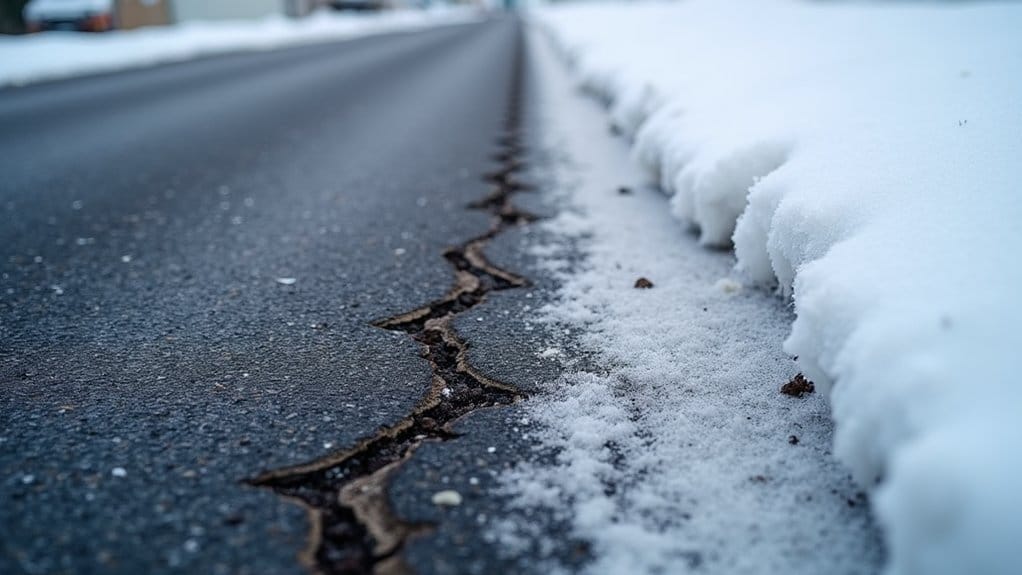
Effective asphalt protection requires specific strategies for each season of the year. Your pavement needs different types of care as temperatures and conditions change.
Start with thorough spring maintenance to repair winter damage. Then shift into summer protection measures. Finally, complete autumn preparations before winter hits.
Your seasonal protection strategy should include these critical actions:
- Conduct pre-season inspections each spring to spot damage early
- Schedule sealcoating during late spring when temperatures are ideal
- Clean surfaces regularly throughout summer to prevent debris buildup
- Seal all cracks during autumn before freeze-thaw cycles begin
- Implement a 3.5-year sealcoating rotation for maximum protection
Don’t wait for problems to develop! Your spring maintenance should focus on repairing winter damage and applying protective sealcoat.
Summer’s your time for thorough cleaning and immediate repairs. When autumn preparations begin, concentrate on crack sealing and debris removal. This proactive approach will save you money and extend your pavement’s life.
Remember: Temperature matters! Never apply sealant when nighttime temperatures drop below 50°F. Additionally, consider hiring a full-service paving company to ensure expert care and quality materials for your asphalt protection.
You’ll get better results by working with nature’s seasons.
Emergency Snow Removal Guidelines
Managing emergency snow removal requires a systematic approach focused on major transportation routes.
You’ll want to follow key guidelines that protect both safety and road surfaces during winter operations.
Priority Planning
- Focus first on high-traffic routes with 2,500+ daily vehicles
- Maintain 24-hour coverage until roads return to normal condition
- Clear snow from shoulders and sight distance areas promptly
Smart Plowing Techniques
Don’t start plowing until there’s enough snow accumulation to warrant the effort.
When you do plow, protect your asphalt by:
- Setting plow blades ½ inch above the surface
- Using rubber or polyurethane cutting edges
- Installing snow blade shoes for gravel areas
- Taking extra care on curves and grade changes
Chemical Treatment Tips
Be strategic with de-icing materials!
You’ll want to:
- Apply anti-icing treatments only on major routes
- Minimize chemical use on porous pavements
- Avoid treating paved shoulders directly
- Watch for freeze-thaw cycles that can damage surfaces
Remember – proper snow removal isn’t just about clearing roads.
It’s about protecting your pavement investment while keeping traffic moving safely!
Conclusion
Your asphalt deserves better than a harsh winter beatdown! With these pro tips, you’ll protect your pavement like a knight guarding their castle. Stay ahead of snow damage by implementing smart removal practices and preventive maintenance. Don’t let freeze-thaw cycles or chemical damage wreck your investment. Call the experts when needed, and you’ll keep your asphalt strong for years to come. Your future self will thank you!
Protect Your Asphalt This Winter in Central PA!
Winter weather can wreak havoc on your asphalt surfaces, but you can act now to safeguard your investment! You don’t want those dreaded freeze-thaw cycles to create costly repairs over time. At Nathan Paving, we offer professional sealing and snow removal services that ensure your asphalt stays in top condition throughout the winter months.
Don’t wait until spring to assess the damage — get a free quote today and discover how our expert services can save you time and money! Visit us at Nathan Paving Free Quote or explore our services, including seal coating and asphalt repairs.
